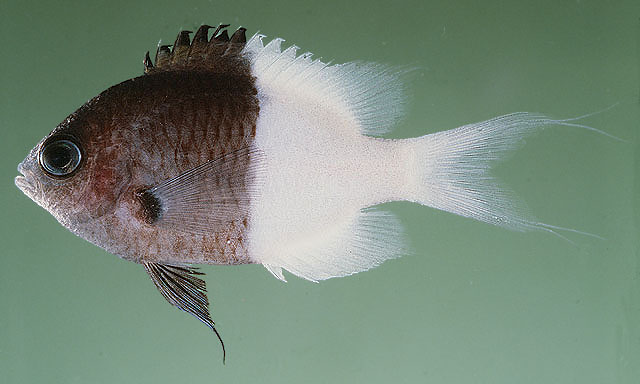| Pomacentridae (Damselfishes), subfamily: Chrominae |
| 8 cm FL (male/unsexed) |
|
reef-associated; marine; depth range 3 - 35 m, non-migratory |
| Pacific Ocean: Great Barrier Reef and northern New Guinea to Samoa and the Society Islands (Ref. 7247). There are no valid records of this species in the western Pacific north of New Guinea, and none for the islands of Micronesia (Ref. 92902). |
|
Dorsal spines (total): 12-12; Dorsal soft rays (total): 13-14; Anal spines: 2-2; Anal soft rays: 13-14. Description: Body and adjacent dorsal and anal fins color is dark brown from snout to about the 4th dorsal-fin spine, then white to the caudal fin. Body short and deep (Ref. 4966). Body depth 1.8-1.9 in SL (Ref. 90102). This species differs from both C. fieldi and C. dimidiata by having 13 or 14 dorsal soft rays compared to modally 12 dorsal rays, the demarcation of dark brown anterior and white posterior colors anterior to the origin of the anal fin (the pectoral-fin tips passing distinctly posterior to the demarcation), and the genetic differentiation is distinct at mtDNA (Ref. 92902). |
| Adults inhabit passages and outer reef slopes, solitarily or in small groups. They are sometimes seen in mixed aggregations with the closely related species C. margaritifer (Ref. 7247). Feeds on planktons (Ref. 89972). Oviparous, distinct pairing during breeding (Ref. 205). Eggs are demersal and adhere to the substrate (Ref. 205). Males guard and aerate the eggs (Ref. 205). Diurnal species (Ref. 54980; 113699). |
|
Least Concern (LC); Date assessed: 01 August 2021 Ref. (130435)
|
| harmless |
Source and more info: www.fishbase.org. For personal, classroom, and other internal use only. Not for publication.

